LAWS20059: Business Structures - Partnership and Company Report
VerifiedAdded on 2022/10/02
|10
|2606
|181
Report
AI Summary
This report provides a detailed comparison of business structures, specifically focusing on partnerships and companies. It examines the liabilities of partners and directors, highlighting the legal distinctions between the two. The report delves into fiduciary duties, outlining the responsibilities of partners and directors, and references relevant legislation and case law, including the Corporations Act 2001 and cases such as ASIC v Adler and ASIC v Vizard. The concept of corporate veil piercing is explained, along with its implications for director liability. The analysis covers the legal framework in Australia, offering insights into the advantages and disadvantages of each structure. The report emphasizes the importance of understanding these legal aspects for individuals considering starting a business, particularly regarding the potential risks associated with third-party legal actions.
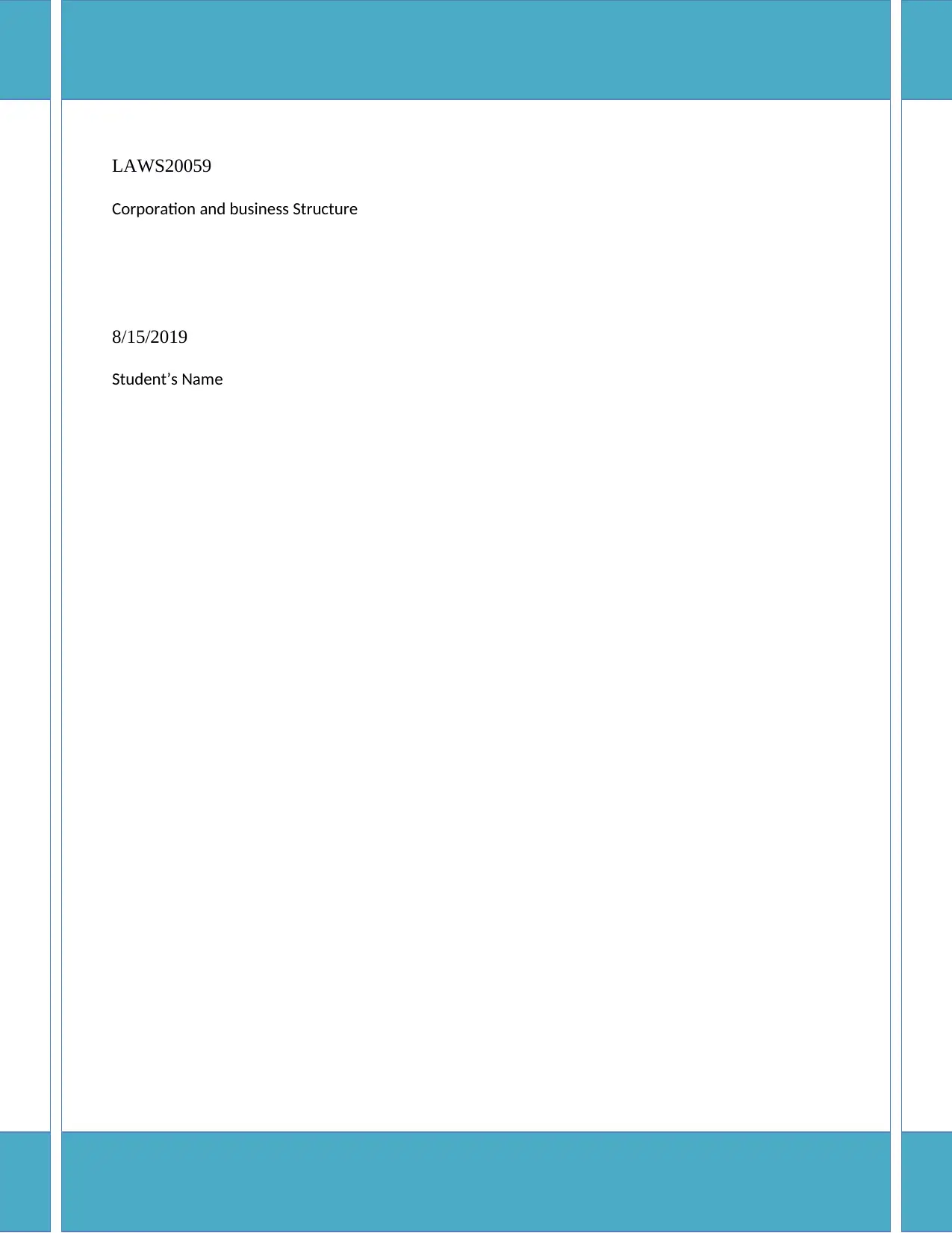
Running Head: BUSINESS AND CORPORATION LAW 0
LAWS20059
Corporation and business Structure
8/15/2019
Student’s Name
LAWS20059
Corporation and business Structure
8/15/2019
Student’s Name
Paraphrase This Document
Need a fresh take? Get an instant paraphrase of this document with our AI Paraphraser
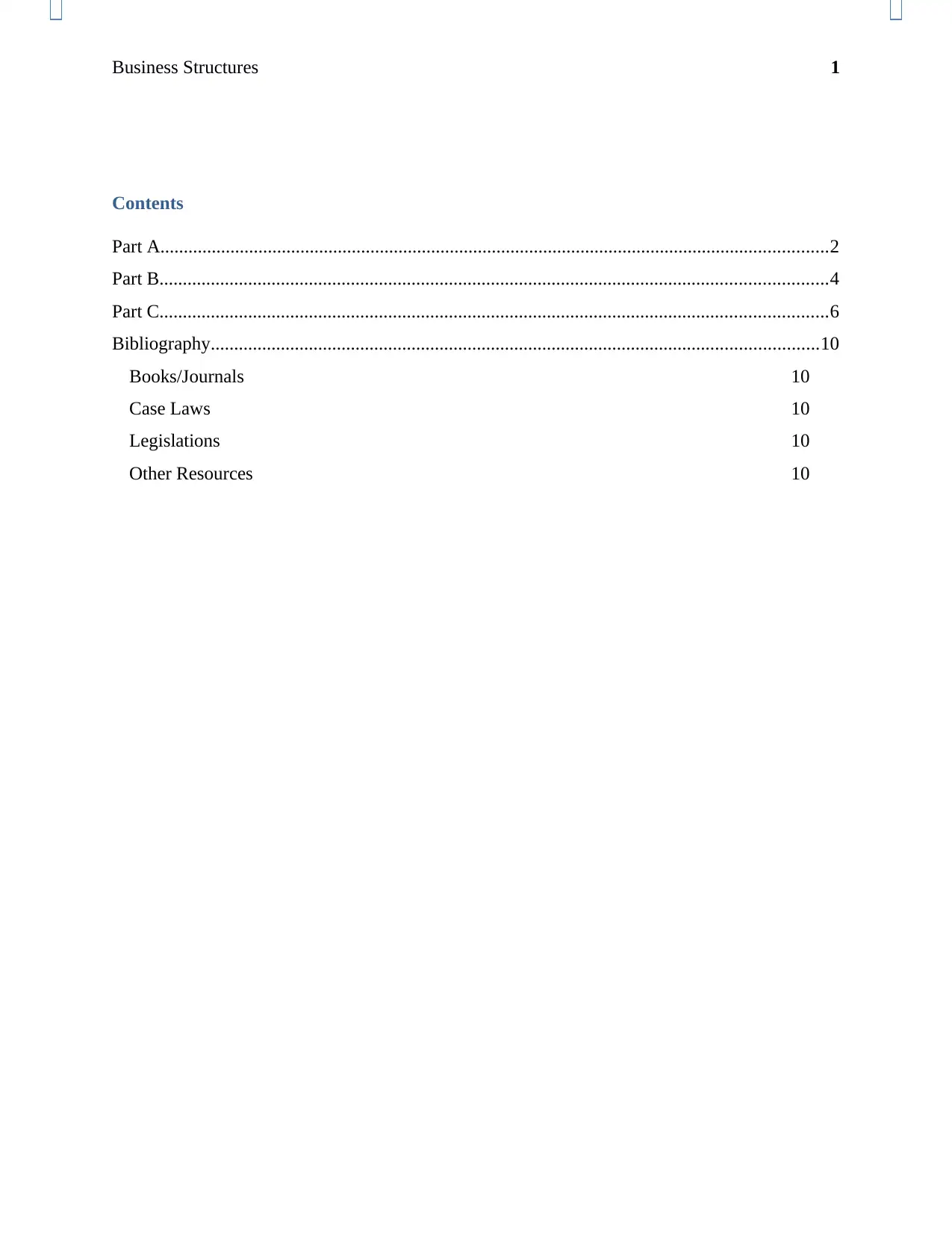
Business Structures 1
Contents
Part A...............................................................................................................................................2
Part B...............................................................................................................................................4
Part C...............................................................................................................................................6
Bibliography..................................................................................................................................10
Books/Journals 10
Case Laws 10
Legislations 10
Other Resources 10
Contents
Part A...............................................................................................................................................2
Part B...............................................................................................................................................4
Part C...............................................................................................................................................6
Bibliography..................................................................................................................................10
Books/Journals 10
Case Laws 10
Legislations 10
Other Resources 10
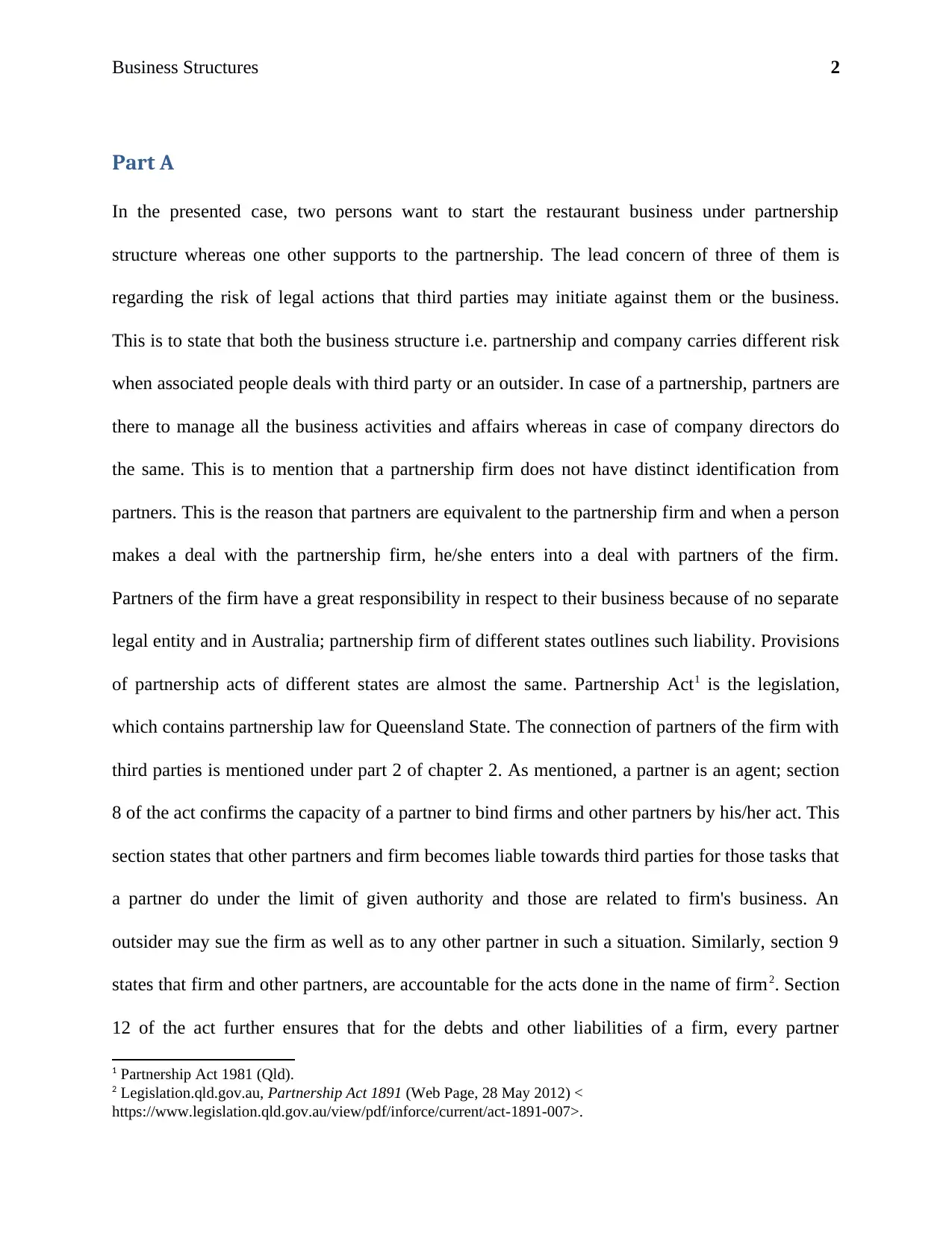
Business Structures 2
Part A
In the presented case, two persons want to start the restaurant business under partnership
structure whereas one other supports to the partnership. The lead concern of three of them is
regarding the risk of legal actions that third parties may initiate against them or the business.
This is to state that both the business structure i.e. partnership and company carries different risk
when associated people deals with third party or an outsider. In case of a partnership, partners are
there to manage all the business activities and affairs whereas in case of company directors do
the same. This is to mention that a partnership firm does not have distinct identification from
partners. This is the reason that partners are equivalent to the partnership firm and when a person
makes a deal with the partnership firm, he/she enters into a deal with partners of the firm.
Partners of the firm have a great responsibility in respect to their business because of no separate
legal entity and in Australia; partnership firm of different states outlines such liability. Provisions
of partnership acts of different states are almost the same. Partnership Act1 is the legislation,
which contains partnership law for Queensland State. The connection of partners of the firm with
third parties is mentioned under part 2 of chapter 2. As mentioned, a partner is an agent; section
8 of the act confirms the capacity of a partner to bind firms and other partners by his/her act. This
section states that other partners and firm becomes liable towards third parties for those tasks that
a partner do under the limit of given authority and those are related to firm's business. An
outsider may sue the firm as well as to any other partner in such a situation. Similarly, section 9
states that firm and other partners, are accountable for the acts done in the name of firm2. Section
12 of the act further ensures that for the debts and other liabilities of a firm, every partner
1 Partnership Act 1981 (Qld).
2 Legislation.qld.gov.au, Partnership Act 1891 (Web Page, 28 May 2012) <
https://www.legislation.qld.gov.au/view/pdf/inforce/current/act-1891-007>.
Part A
In the presented case, two persons want to start the restaurant business under partnership
structure whereas one other supports to the partnership. The lead concern of three of them is
regarding the risk of legal actions that third parties may initiate against them or the business.
This is to state that both the business structure i.e. partnership and company carries different risk
when associated people deals with third party or an outsider. In case of a partnership, partners are
there to manage all the business activities and affairs whereas in case of company directors do
the same. This is to mention that a partnership firm does not have distinct identification from
partners. This is the reason that partners are equivalent to the partnership firm and when a person
makes a deal with the partnership firm, he/she enters into a deal with partners of the firm.
Partners of the firm have a great responsibility in respect to their business because of no separate
legal entity and in Australia; partnership firm of different states outlines such liability. Provisions
of partnership acts of different states are almost the same. Partnership Act1 is the legislation,
which contains partnership law for Queensland State. The connection of partners of the firm with
third parties is mentioned under part 2 of chapter 2. As mentioned, a partner is an agent; section
8 of the act confirms the capacity of a partner to bind firms and other partners by his/her act. This
section states that other partners and firm becomes liable towards third parties for those tasks that
a partner do under the limit of given authority and those are related to firm's business. An
outsider may sue the firm as well as to any other partner in such a situation. Similarly, section 9
states that firm and other partners, are accountable for the acts done in the name of firm2. Section
12 of the act further ensures that for the debts and other liabilities of a firm, every partner
1 Partnership Act 1981 (Qld).
2 Legislation.qld.gov.au, Partnership Act 1891 (Web Page, 28 May 2012) <
https://www.legislation.qld.gov.au/view/pdf/inforce/current/act-1891-007>.
⊘ This is a preview!⊘
Do you want full access?
Subscribe today to unlock all pages.

Trusted by 1+ million students worldwide
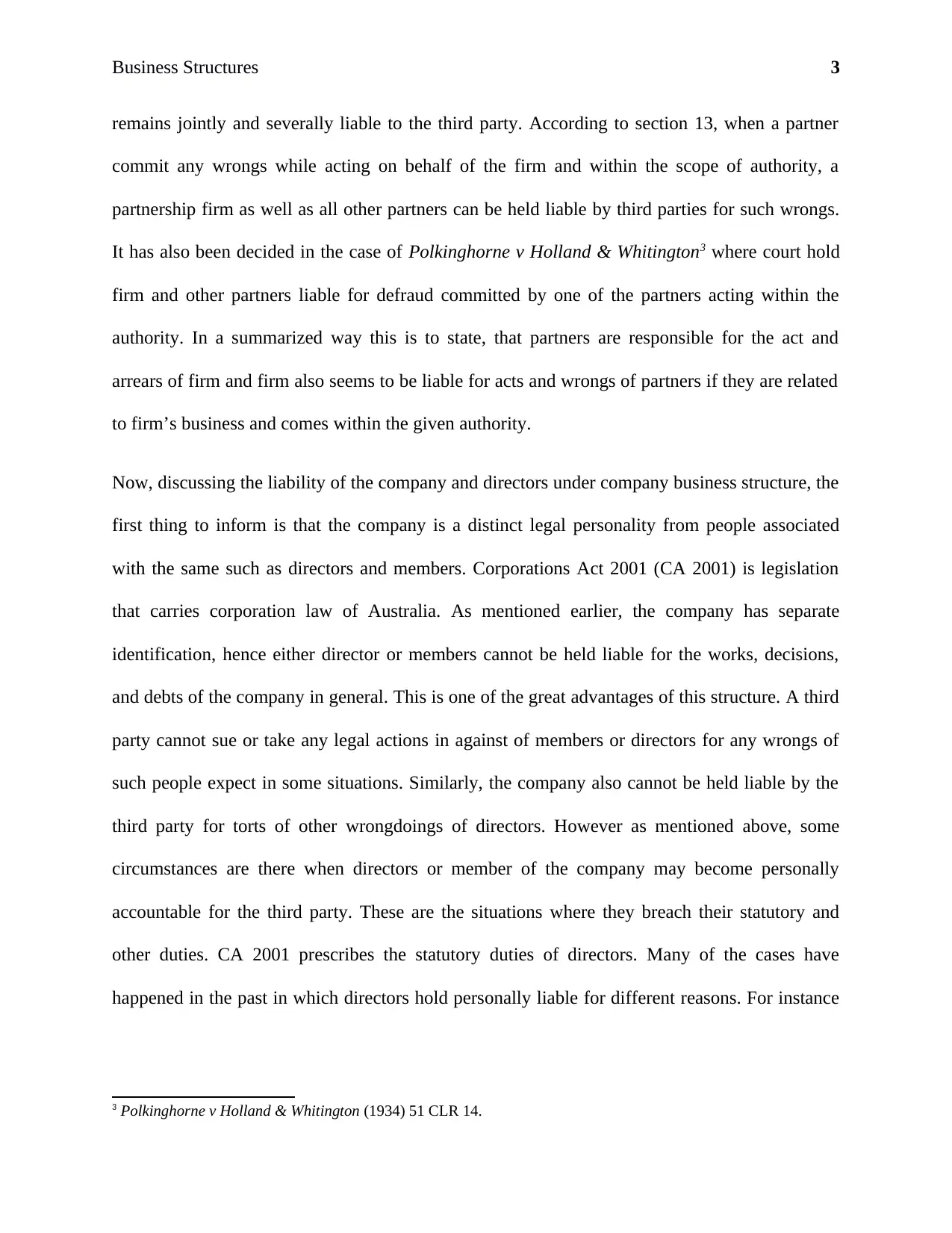
Business Structures 3
remains jointly and severally liable to the third party. According to section 13, when a partner
commit any wrongs while acting on behalf of the firm and within the scope of authority, a
partnership firm as well as all other partners can be held liable by third parties for such wrongs.
It has also been decided in the case of Polkinghorne v Holland & Whitington3 where court hold
firm and other partners liable for defraud committed by one of the partners acting within the
authority. In a summarized way this is to state, that partners are responsible for the act and
arrears of firm and firm also seems to be liable for acts and wrongs of partners if they are related
to firm’s business and comes within the given authority.
Now, discussing the liability of the company and directors under company business structure, the
first thing to inform is that the company is a distinct legal personality from people associated
with the same such as directors and members. Corporations Act 2001 (CA 2001) is legislation
that carries corporation law of Australia. As mentioned earlier, the company has separate
identification, hence either director or members cannot be held liable for the works, decisions,
and debts of the company in general. This is one of the great advantages of this structure. A third
party cannot sue or take any legal actions in against of members or directors for any wrongs of
such people expect in some situations. Similarly, the company also cannot be held liable by the
third party for torts of other wrongdoings of directors. However as mentioned above, some
circumstances are there when directors or member of the company may become personally
accountable for the third party. These are the situations where they breach their statutory and
other duties. CA 2001 prescribes the statutory duties of directors. Many of the cases have
happened in the past in which directors hold personally liable for different reasons. For instance
3 Polkinghorne v Holland & Whitington (1934) 51 CLR 14.
remains jointly and severally liable to the third party. According to section 13, when a partner
commit any wrongs while acting on behalf of the firm and within the scope of authority, a
partnership firm as well as all other partners can be held liable by third parties for such wrongs.
It has also been decided in the case of Polkinghorne v Holland & Whitington3 where court hold
firm and other partners liable for defraud committed by one of the partners acting within the
authority. In a summarized way this is to state, that partners are responsible for the act and
arrears of firm and firm also seems to be liable for acts and wrongs of partners if they are related
to firm’s business and comes within the given authority.
Now, discussing the liability of the company and directors under company business structure, the
first thing to inform is that the company is a distinct legal personality from people associated
with the same such as directors and members. Corporations Act 2001 (CA 2001) is legislation
that carries corporation law of Australia. As mentioned earlier, the company has separate
identification, hence either director or members cannot be held liable for the works, decisions,
and debts of the company in general. This is one of the great advantages of this structure. A third
party cannot sue or take any legal actions in against of members or directors for any wrongs of
such people expect in some situations. Similarly, the company also cannot be held liable by the
third party for torts of other wrongdoings of directors. However as mentioned above, some
circumstances are there when directors or member of the company may become personally
accountable for the third party. These are the situations where they breach their statutory and
other duties. CA 2001 prescribes the statutory duties of directors. Many of the cases have
happened in the past in which directors hold personally liable for different reasons. For instance
3 Polkinghorne v Holland & Whitington (1934) 51 CLR 14.
Paraphrase This Document
Need a fresh take? Get an instant paraphrase of this document with our AI Paraphraser
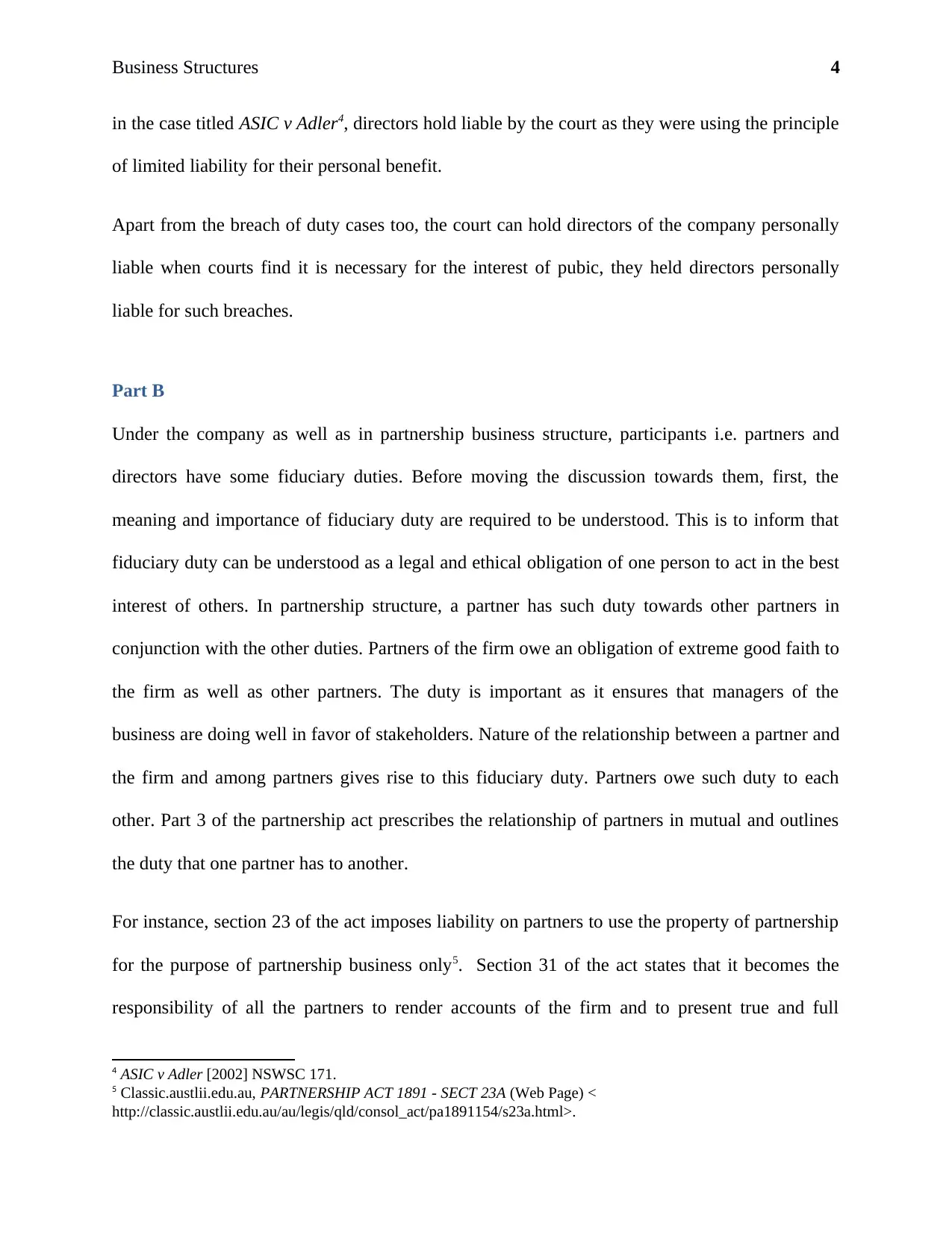
Business Structures 4
in the case titled ASIC v Adler4, directors hold liable by the court as they were using the principle
of limited liability for their personal benefit.
Apart from the breach of duty cases too, the court can hold directors of the company personally
liable when courts find it is necessary for the interest of pubic, they held directors personally
liable for such breaches.
Part B
Under the company as well as in partnership business structure, participants i.e. partners and
directors have some fiduciary duties. Before moving the discussion towards them, first, the
meaning and importance of fiduciary duty are required to be understood. This is to inform that
fiduciary duty can be understood as a legal and ethical obligation of one person to act in the best
interest of others. In partnership structure, a partner has such duty towards other partners in
conjunction with the other duties. Partners of the firm owe an obligation of extreme good faith to
the firm as well as other partners. The duty is important as it ensures that managers of the
business are doing well in favor of stakeholders. Nature of the relationship between a partner and
the firm and among partners gives rise to this fiduciary duty. Partners owe such duty to each
other. Part 3 of the partnership act prescribes the relationship of partners in mutual and outlines
the duty that one partner has to another.
For instance, section 23 of the act imposes liability on partners to use the property of partnership
for the purpose of partnership business only5. Section 31 of the act states that it becomes the
responsibility of all the partners to render accounts of the firm and to present true and full
4 ASIC v Adler [2002] NSWSC 171.
5 Classic.austlii.edu.au, PARTNERSHIP ACT 1891 - SECT 23A (Web Page) <
http://classic.austlii.edu.au/au/legis/qld/consol_act/pa1891154/s23a.html>.
in the case titled ASIC v Adler4, directors hold liable by the court as they were using the principle
of limited liability for their personal benefit.
Apart from the breach of duty cases too, the court can hold directors of the company personally
liable when courts find it is necessary for the interest of pubic, they held directors personally
liable for such breaches.
Part B
Under the company as well as in partnership business structure, participants i.e. partners and
directors have some fiduciary duties. Before moving the discussion towards them, first, the
meaning and importance of fiduciary duty are required to be understood. This is to inform that
fiduciary duty can be understood as a legal and ethical obligation of one person to act in the best
interest of others. In partnership structure, a partner has such duty towards other partners in
conjunction with the other duties. Partners of the firm owe an obligation of extreme good faith to
the firm as well as other partners. The duty is important as it ensures that managers of the
business are doing well in favor of stakeholders. Nature of the relationship between a partner and
the firm and among partners gives rise to this fiduciary duty. Partners owe such duty to each
other. Part 3 of the partnership act prescribes the relationship of partners in mutual and outlines
the duty that one partner has to another.
For instance, section 23 of the act imposes liability on partners to use the property of partnership
for the purpose of partnership business only5. Section 31 of the act states that it becomes the
responsibility of all the partners to render accounts of the firm and to present true and full
4 ASIC v Adler [2002] NSWSC 171.
5 Classic.austlii.edu.au, PARTNERSHIP ACT 1891 - SECT 23A (Web Page) <
http://classic.austlii.edu.au/au/legis/qld/consol_act/pa1891154/s23a.html>.
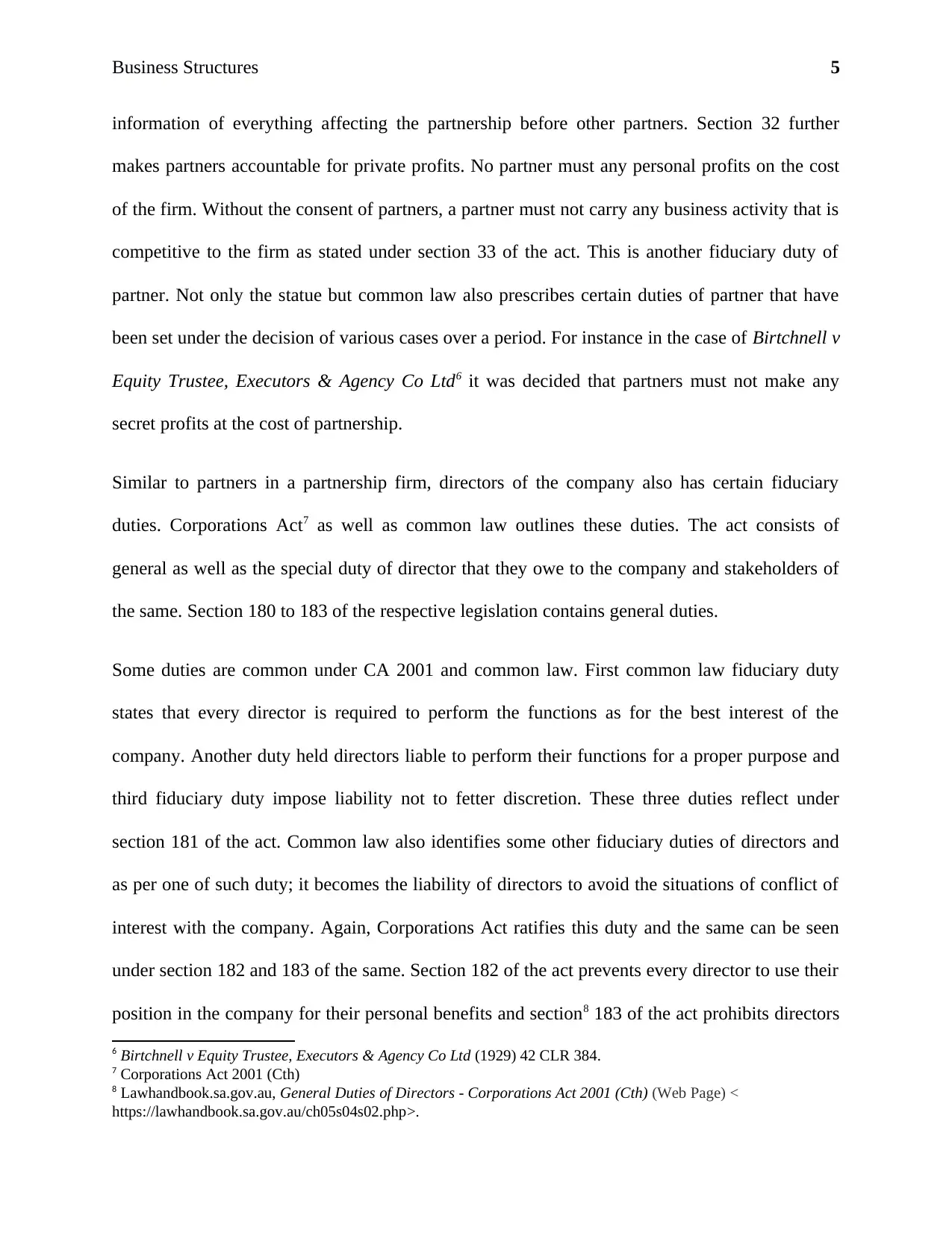
Business Structures 5
information of everything affecting the partnership before other partners. Section 32 further
makes partners accountable for private profits. No partner must any personal profits on the cost
of the firm. Without the consent of partners, a partner must not carry any business activity that is
competitive to the firm as stated under section 33 of the act. This is another fiduciary duty of
partner. Not only the statue but common law also prescribes certain duties of partner that have
been set under the decision of various cases over a period. For instance in the case of Birtchnell v
Equity Trustee, Executors & Agency Co Ltd6 it was decided that partners must not make any
secret profits at the cost of partnership.
Similar to partners in a partnership firm, directors of the company also has certain fiduciary
duties. Corporations Act7 as well as common law outlines these duties. The act consists of
general as well as the special duty of director that they owe to the company and stakeholders of
the same. Section 180 to 183 of the respective legislation contains general duties.
Some duties are common under CA 2001 and common law. First common law fiduciary duty
states that every director is required to perform the functions as for the best interest of the
company. Another duty held directors liable to perform their functions for a proper purpose and
third fiduciary duty impose liability not to fetter discretion. These three duties reflect under
section 181 of the act. Common law also identifies some other fiduciary duties of directors and
as per one of such duty; it becomes the liability of directors to avoid the situations of conflict of
interest with the company. Again, Corporations Act ratifies this duty and the same can be seen
under section 182 and 183 of the same. Section 182 of the act prevents every director to use their
position in the company for their personal benefits and section8 183 of the act prohibits directors
6 Birtchnell v Equity Trustee, Executors & Agency Co Ltd (1929) 42 CLR 384.
7 Corporations Act 2001 (Cth)
8 Lawhandbook.sa.gov.au, General Duties of Directors - Corporations Act 2001 (Cth) (Web Page) <
https://lawhandbook.sa.gov.au/ch05s04s02.php>.
information of everything affecting the partnership before other partners. Section 32 further
makes partners accountable for private profits. No partner must any personal profits on the cost
of the firm. Without the consent of partners, a partner must not carry any business activity that is
competitive to the firm as stated under section 33 of the act. This is another fiduciary duty of
partner. Not only the statue but common law also prescribes certain duties of partner that have
been set under the decision of various cases over a period. For instance in the case of Birtchnell v
Equity Trustee, Executors & Agency Co Ltd6 it was decided that partners must not make any
secret profits at the cost of partnership.
Similar to partners in a partnership firm, directors of the company also has certain fiduciary
duties. Corporations Act7 as well as common law outlines these duties. The act consists of
general as well as the special duty of director that they owe to the company and stakeholders of
the same. Section 180 to 183 of the respective legislation contains general duties.
Some duties are common under CA 2001 and common law. First common law fiduciary duty
states that every director is required to perform the functions as for the best interest of the
company. Another duty held directors liable to perform their functions for a proper purpose and
third fiduciary duty impose liability not to fetter discretion. These three duties reflect under
section 181 of the act. Common law also identifies some other fiduciary duties of directors and
as per one of such duty; it becomes the liability of directors to avoid the situations of conflict of
interest with the company. Again, Corporations Act ratifies this duty and the same can be seen
under section 182 and 183 of the same. Section 182 of the act prevents every director to use their
position in the company for their personal benefits and section8 183 of the act prohibits directors
6 Birtchnell v Equity Trustee, Executors & Agency Co Ltd (1929) 42 CLR 384.
7 Corporations Act 2001 (Cth)
8 Lawhandbook.sa.gov.au, General Duties of Directors - Corporations Act 2001 (Cth) (Web Page) <
https://lawhandbook.sa.gov.au/ch05s04s02.php>.
⊘ This is a preview!⊘
Do you want full access?
Subscribe today to unlock all pages.

Trusted by 1+ million students worldwide
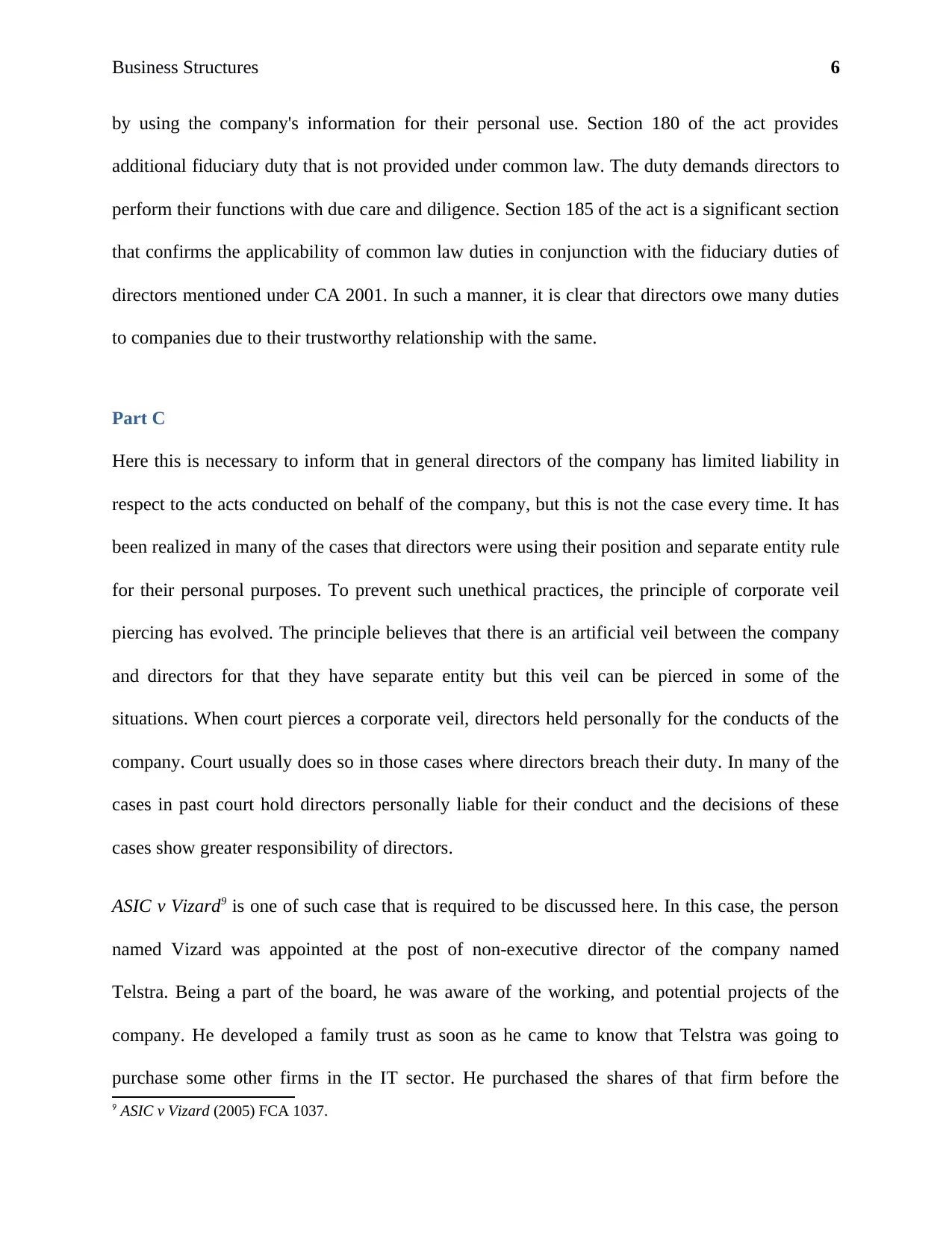
Business Structures 6
by using the company's information for their personal use. Section 180 of the act provides
additional fiduciary duty that is not provided under common law. The duty demands directors to
perform their functions with due care and diligence. Section 185 of the act is a significant section
that confirms the applicability of common law duties in conjunction with the fiduciary duties of
directors mentioned under CA 2001. In such a manner, it is clear that directors owe many duties
to companies due to their trustworthy relationship with the same.
Part C
Here this is necessary to inform that in general directors of the company has limited liability in
respect to the acts conducted on behalf of the company, but this is not the case every time. It has
been realized in many of the cases that directors were using their position and separate entity rule
for their personal purposes. To prevent such unethical practices, the principle of corporate veil
piercing has evolved. The principle believes that there is an artificial veil between the company
and directors for that they have separate entity but this veil can be pierced in some of the
situations. When court pierces a corporate veil, directors held personally for the conducts of the
company. Court usually does so in those cases where directors breach their duty. In many of the
cases in past court hold directors personally liable for their conduct and the decisions of these
cases show greater responsibility of directors.
ASIC v Vizard9 is one of such case that is required to be discussed here. In this case, the person
named Vizard was appointed at the post of non-executive director of the company named
Telstra. Being a part of the board, he was aware of the working, and potential projects of the
company. He developed a family trust as soon as he came to know that Telstra was going to
purchase some other firms in the IT sector. He purchased the shares of that firm before the
9 ASIC v Vizard (2005) FCA 1037.
by using the company's information for their personal use. Section 180 of the act provides
additional fiduciary duty that is not provided under common law. The duty demands directors to
perform their functions with due care and diligence. Section 185 of the act is a significant section
that confirms the applicability of common law duties in conjunction with the fiduciary duties of
directors mentioned under CA 2001. In such a manner, it is clear that directors owe many duties
to companies due to their trustworthy relationship with the same.
Part C
Here this is necessary to inform that in general directors of the company has limited liability in
respect to the acts conducted on behalf of the company, but this is not the case every time. It has
been realized in many of the cases that directors were using their position and separate entity rule
for their personal purposes. To prevent such unethical practices, the principle of corporate veil
piercing has evolved. The principle believes that there is an artificial veil between the company
and directors for that they have separate entity but this veil can be pierced in some of the
situations. When court pierces a corporate veil, directors held personally for the conducts of the
company. Court usually does so in those cases where directors breach their duty. In many of the
cases in past court hold directors personally liable for their conduct and the decisions of these
cases show greater responsibility of directors.
ASIC v Vizard9 is one of such case that is required to be discussed here. In this case, the person
named Vizard was appointed at the post of non-executive director of the company named
Telstra. Being a part of the board, he was aware of the working, and potential projects of the
company. He developed a family trust as soon as he came to know that Telstra was going to
purchase some other firms in the IT sector. He purchased the shares of that firm before the
9 ASIC v Vizard (2005) FCA 1037.
Paraphrase This Document
Need a fresh take? Get an instant paraphrase of this document with our AI Paraphraser
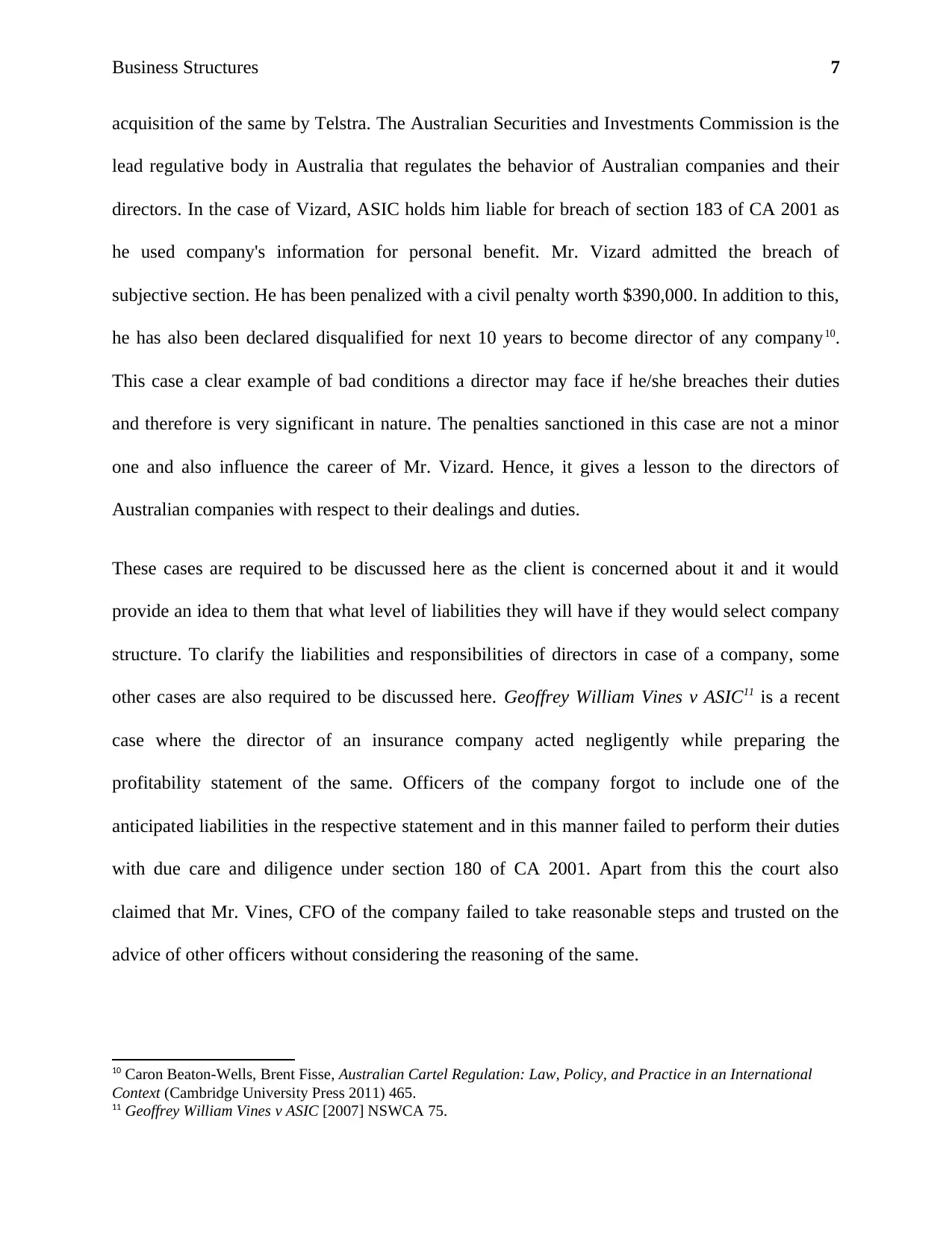
Business Structures 7
acquisition of the same by Telstra. The Australian Securities and Investments Commission is the
lead regulative body in Australia that regulates the behavior of Australian companies and their
directors. In the case of Vizard, ASIC holds him liable for breach of section 183 of CA 2001 as
he used company's information for personal benefit. Mr. Vizard admitted the breach of
subjective section. He has been penalized with a civil penalty worth $390,000. In addition to this,
he has also been declared disqualified for next 10 years to become director of any company10.
This case a clear example of bad conditions a director may face if he/she breaches their duties
and therefore is very significant in nature. The penalties sanctioned in this case are not a minor
one and also influence the career of Mr. Vizard. Hence, it gives a lesson to the directors of
Australian companies with respect to their dealings and duties.
These cases are required to be discussed here as the client is concerned about it and it would
provide an idea to them that what level of liabilities they will have if they would select company
structure. To clarify the liabilities and responsibilities of directors in case of a company, some
other cases are also required to be discussed here. Geoffrey William Vines v ASIC11 is a recent
case where the director of an insurance company acted negligently while preparing the
profitability statement of the same. Officers of the company forgot to include one of the
anticipated liabilities in the respective statement and in this manner failed to perform their duties
with due care and diligence under section 180 of CA 2001. Apart from this the court also
claimed that Mr. Vines, CFO of the company failed to take reasonable steps and trusted on the
advice of other officers without considering the reasoning of the same.
10 Caron Beaton-Wells, Brent Fisse, Australian Cartel Regulation: Law, Policy, and Practice in an International
Context (Cambridge University Press 2011) 465.
11 Geoffrey William Vines v ASIC [2007] NSWCA 75.
acquisition of the same by Telstra. The Australian Securities and Investments Commission is the
lead regulative body in Australia that regulates the behavior of Australian companies and their
directors. In the case of Vizard, ASIC holds him liable for breach of section 183 of CA 2001 as
he used company's information for personal benefit. Mr. Vizard admitted the breach of
subjective section. He has been penalized with a civil penalty worth $390,000. In addition to this,
he has also been declared disqualified for next 10 years to become director of any company10.
This case a clear example of bad conditions a director may face if he/she breaches their duties
and therefore is very significant in nature. The penalties sanctioned in this case are not a minor
one and also influence the career of Mr. Vizard. Hence, it gives a lesson to the directors of
Australian companies with respect to their dealings and duties.
These cases are required to be discussed here as the client is concerned about it and it would
provide an idea to them that what level of liabilities they will have if they would select company
structure. To clarify the liabilities and responsibilities of directors in case of a company, some
other cases are also required to be discussed here. Geoffrey William Vines v ASIC11 is a recent
case where the director of an insurance company acted negligently while preparing the
profitability statement of the same. Officers of the company forgot to include one of the
anticipated liabilities in the respective statement and in this manner failed to perform their duties
with due care and diligence under section 180 of CA 2001. Apart from this the court also
claimed that Mr. Vines, CFO of the company failed to take reasonable steps and trusted on the
advice of other officers without considering the reasoning of the same.
10 Caron Beaton-Wells, Brent Fisse, Australian Cartel Regulation: Law, Policy, and Practice in an International
Context (Cambridge University Press 2011) 465.
11 Geoffrey William Vines v ASIC [2007] NSWCA 75.
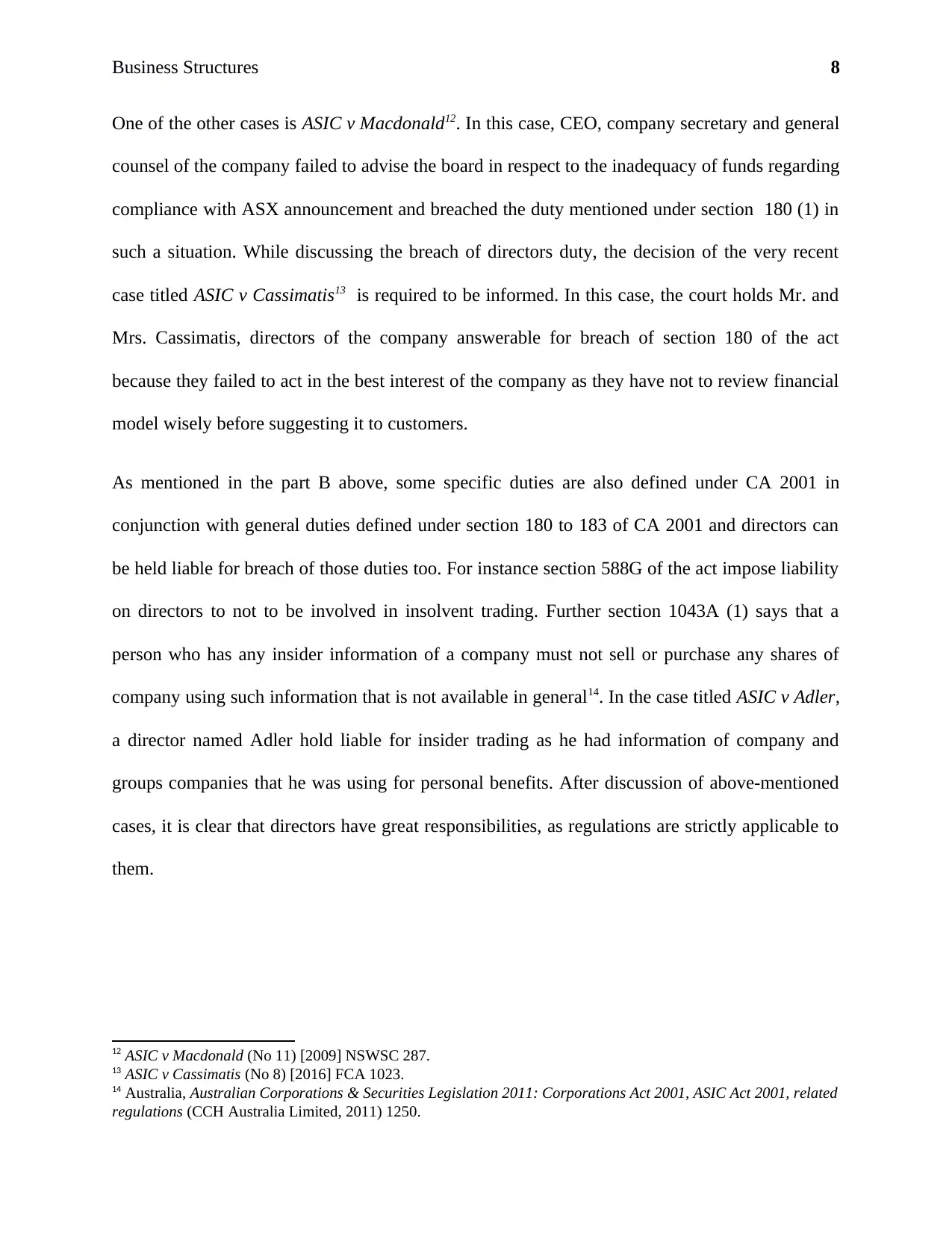
Business Structures 8
One of the other cases is ASIC v Macdonald12. In this case, CEO, company secretary and general
counsel of the company failed to advise the board in respect to the inadequacy of funds regarding
compliance with ASX announcement and breached the duty mentioned under section 180 (1) in
such a situation. While discussing the breach of directors duty, the decision of the very recent
case titled ASIC v Cassimatis13 is required to be informed. In this case, the court holds Mr. and
Mrs. Cassimatis, directors of the company answerable for breach of section 180 of the act
because they failed to act in the best interest of the company as they have not to review financial
model wisely before suggesting it to customers.
As mentioned in the part B above, some specific duties are also defined under CA 2001 in
conjunction with general duties defined under section 180 to 183 of CA 2001 and directors can
be held liable for breach of those duties too. For instance section 588G of the act impose liability
on directors to not to be involved in insolvent trading. Further section 1043A (1) says that a
person who has any insider information of a company must not sell or purchase any shares of
company using such information that is not available in general14. In the case titled ASIC v Adler,
a director named Adler hold liable for insider trading as he had information of company and
groups companies that he was using for personal benefits. After discussion of above-mentioned
cases, it is clear that directors have great responsibilities, as regulations are strictly applicable to
them.
12 ASIC v Macdonald (No 11) [2009] NSWSC 287.
13 ASIC v Cassimatis (No 8) [2016] FCA 1023.
14 Australia, Australian Corporations & Securities Legislation 2011: Corporations Act 2001, ASIC Act 2001, related
regulations (CCH Australia Limited, 2011) 1250.
One of the other cases is ASIC v Macdonald12. In this case, CEO, company secretary and general
counsel of the company failed to advise the board in respect to the inadequacy of funds regarding
compliance with ASX announcement and breached the duty mentioned under section 180 (1) in
such a situation. While discussing the breach of directors duty, the decision of the very recent
case titled ASIC v Cassimatis13 is required to be informed. In this case, the court holds Mr. and
Mrs. Cassimatis, directors of the company answerable for breach of section 180 of the act
because they failed to act in the best interest of the company as they have not to review financial
model wisely before suggesting it to customers.
As mentioned in the part B above, some specific duties are also defined under CA 2001 in
conjunction with general duties defined under section 180 to 183 of CA 2001 and directors can
be held liable for breach of those duties too. For instance section 588G of the act impose liability
on directors to not to be involved in insolvent trading. Further section 1043A (1) says that a
person who has any insider information of a company must not sell or purchase any shares of
company using such information that is not available in general14. In the case titled ASIC v Adler,
a director named Adler hold liable for insider trading as he had information of company and
groups companies that he was using for personal benefits. After discussion of above-mentioned
cases, it is clear that directors have great responsibilities, as regulations are strictly applicable to
them.
12 ASIC v Macdonald (No 11) [2009] NSWSC 287.
13 ASIC v Cassimatis (No 8) [2016] FCA 1023.
14 Australia, Australian Corporations & Securities Legislation 2011: Corporations Act 2001, ASIC Act 2001, related
regulations (CCH Australia Limited, 2011) 1250.
⊘ This is a preview!⊘
Do you want full access?
Subscribe today to unlock all pages.

Trusted by 1+ million students worldwide
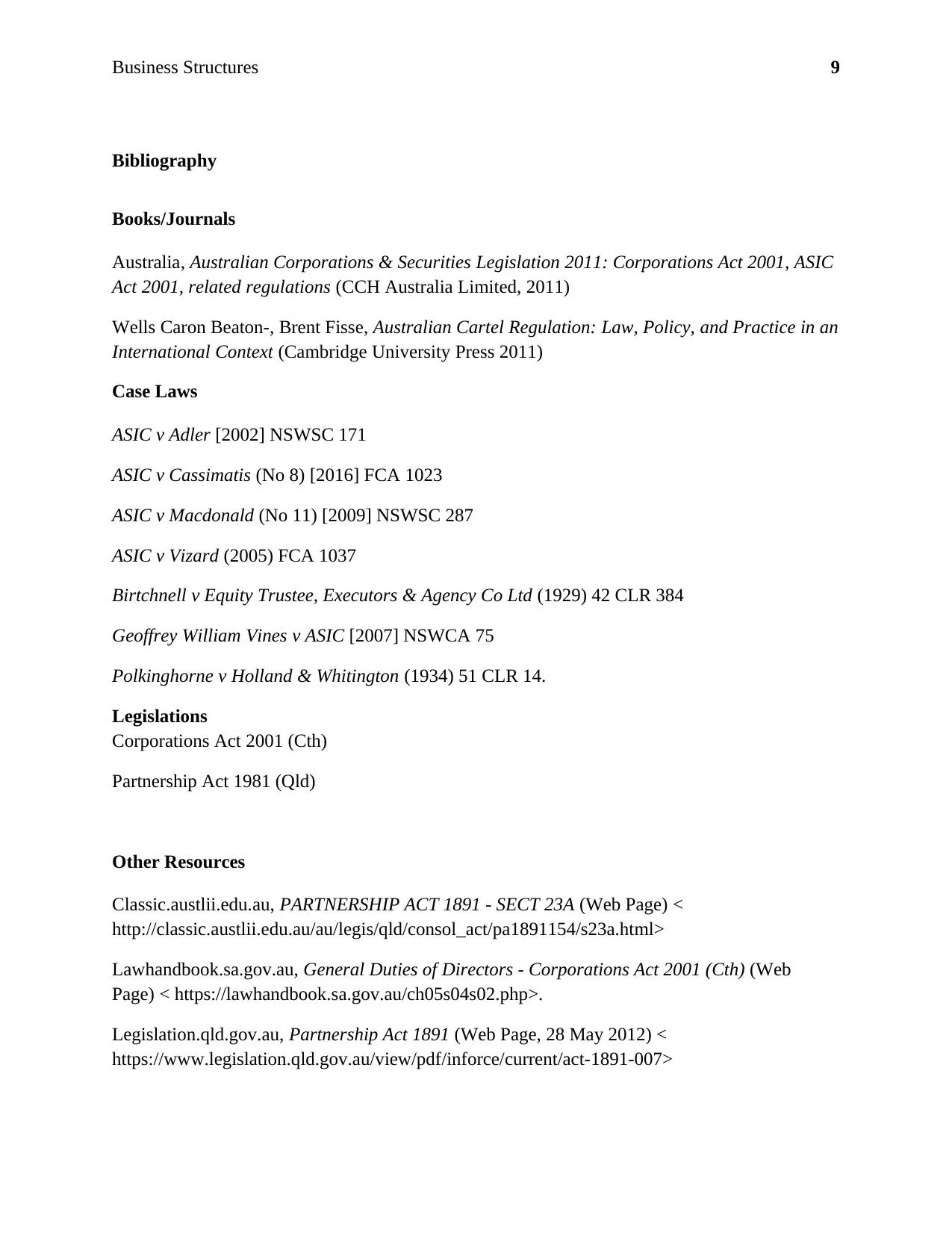
Business Structures 9
Bibliography
Books/Journals
Australia, Australian Corporations & Securities Legislation 2011: Corporations Act 2001, ASIC
Act 2001, related regulations (CCH Australia Limited, 2011)
Wells Caron Beaton-, Brent Fisse, Australian Cartel Regulation: Law, Policy, and Practice in an
International Context (Cambridge University Press 2011)
Case Laws
ASIC v Adler [2002] NSWSC 171
ASIC v Cassimatis (No 8) [2016] FCA 1023
ASIC v Macdonald (No 11) [2009] NSWSC 287
ASIC v Vizard (2005) FCA 1037
Birtchnell v Equity Trustee, Executors & Agency Co Ltd (1929) 42 CLR 384
Geoffrey William Vines v ASIC [2007] NSWCA 75
Polkinghorne v Holland & Whitington (1934) 51 CLR 14.
Legislations
Corporations Act 2001 (Cth)
Partnership Act 1981 (Qld)
Other Resources
Classic.austlii.edu.au, PARTNERSHIP ACT 1891 - SECT 23A (Web Page) <
http://classic.austlii.edu.au/au/legis/qld/consol_act/pa1891154/s23a.html>
Lawhandbook.sa.gov.au, General Duties of Directors - Corporations Act 2001 (Cth) (Web
Page) < https://lawhandbook.sa.gov.au/ch05s04s02.php>.
Legislation.qld.gov.au, Partnership Act 1891 (Web Page, 28 May 2012) <
https://www.legislation.qld.gov.au/view/pdf/inforce/current/act-1891-007>
Bibliography
Books/Journals
Australia, Australian Corporations & Securities Legislation 2011: Corporations Act 2001, ASIC
Act 2001, related regulations (CCH Australia Limited, 2011)
Wells Caron Beaton-, Brent Fisse, Australian Cartel Regulation: Law, Policy, and Practice in an
International Context (Cambridge University Press 2011)
Case Laws
ASIC v Adler [2002] NSWSC 171
ASIC v Cassimatis (No 8) [2016] FCA 1023
ASIC v Macdonald (No 11) [2009] NSWSC 287
ASIC v Vizard (2005) FCA 1037
Birtchnell v Equity Trustee, Executors & Agency Co Ltd (1929) 42 CLR 384
Geoffrey William Vines v ASIC [2007] NSWCA 75
Polkinghorne v Holland & Whitington (1934) 51 CLR 14.
Legislations
Corporations Act 2001 (Cth)
Partnership Act 1981 (Qld)
Other Resources
Classic.austlii.edu.au, PARTNERSHIP ACT 1891 - SECT 23A (Web Page) <
http://classic.austlii.edu.au/au/legis/qld/consol_act/pa1891154/s23a.html>
Lawhandbook.sa.gov.au, General Duties of Directors - Corporations Act 2001 (Cth) (Web
Page) < https://lawhandbook.sa.gov.au/ch05s04s02.php>.
Legislation.qld.gov.au, Partnership Act 1891 (Web Page, 28 May 2012) <
https://www.legislation.qld.gov.au/view/pdf/inforce/current/act-1891-007>
1 out of 10
Related Documents
Your All-in-One AI-Powered Toolkit for Academic Success.
+13062052269
info@desklib.com
Available 24*7 on WhatsApp / Email
![[object Object]](/_next/static/media/star-bottom.7253800d.svg)
Unlock your academic potential
Copyright © 2020–2025 A2Z Services. All Rights Reserved. Developed and managed by ZUCOL.





